Where Is Zone 9 For Gardening
What You'll Learn:
- What Are Planting Zones?
- What Planting Zone Am I In?
- What is Plant Hardiness?
- Breakdown of Plant Hardiness Zones
What Are Planting Zones?
Planting zones are areas you can find on a growing zone map that show exactly which plants are best suited to thrive in your given area, or zone. When shopping for new plants for your garden landscape, the terms "plant hardiness zones," "growing zones" and "planting zones" may at first seem a bit confusing. In essence, plant hardiness zones have been used by growers for years to simply identify the plants that are most likely to survive the winter in their area. Being able to understand a hardiness zone map means you'll have a starting point for making wise planting decisions.
Temperature Range for Planting Zones

Planting zones are broken down into thirteen areas, also known as USDA zones, which cover the entire United States, including Hawaii, Alaska and Puerto Rico. Each agricultural zone covers a 10-degree range. Zone 1 is the coldest, with an average minimum winter temperature of -60 to -50 degrees F, while the minimum winter average temperature in Zone 13 is 60 to 70 degrees F.
What Planting Zone Am I In?
Understanding gardening zones means you can focus your time and attention (not to mention money) on plants with the best chance of winter survival. Gilmour's Interactive U.S. Planting Zone Map for 2019 combines data from the USDA with specific geographical information to provide a complete look at your growing area. Each of the 13 zones on our interactive planting zone map is broken down into two parts to give 5-degree increments in each zone. By asking what zone am I in and using an interactive growing zone map like ours, you may be pleasantly surprised, ultimately discovering you can grow many plants you might not have even considered!
Instead of simply assuming you are in a certain zone and thinking you already know what grows best, click on the major metros near you to see detailed information specific to your exact area. Individual zones are no longer simply just bands that go across the country. Detailed sections are now based on multiple factors.
Click on your state to reveal a basic overview, including the state flower, a list of major metro areas, gardening zones and an overview of climate. By clicking your closest metro area, you'll find even more detailed information to help make your gardening decisions.
At the metro level, you'll be able to access:
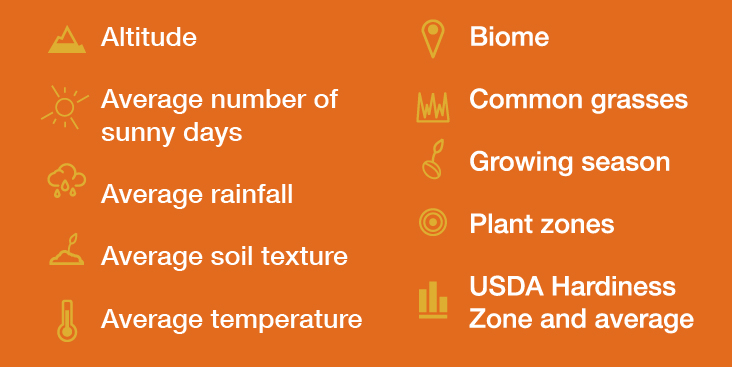
What is Plant Hardiness?
Plant hardiness is the ability of a plant to survive adverse growing climates such as drought, flooding, heat and cold. The science behind plant hardiness can be complicated. Plant genetics determine the ability of a plant to withstand cold temperatures without damage. Each cultivar of a plant may have different hardiness levels based on their adaptations and genetics. Even different parts of a plant may be hardy in different ways. For example, the cold may cause your beloved perennial to die; however, the roots might be hardy enough to bring new growth in the spring.
Many plants require very specific growing environments to thrive. You can adjust many things, such as soil type, moisture levels and amount of sunlight in your garden, but temperature can be hard to control. Choosing plants with hardiness levels appropriate to specific planting zones gives you the best chance of gardening and landscaping success.
Breakdown of Plant Hardiness Zones
In the simplest terms, USDA hardiness zones keep a grower in Alaska from making the mistake of planting peach trees. Understanding the different plant hardiness zones gives you the ability to narrow down your gardening choices. Keep in mind, when a plant is hardy to a specific zone, it will usually perform well at any zone number that's higher as well. For example, most plants hardy to Zone 3 will perform well in Zone 7, as long as other plant requirements are met. Use the information about individual growing zones as a starting point for planning what to plant in your garden. Scroll to read more about each hardiness planting zone or jump directly to your zone using the links below:
Zone 1 | Zone 2 | Zone 3 | Zone 4 | Zone 5 | Zone 6 | Zone 7 | Zone 8 | Zone 9 | Zone 10 | Zone 11 | Zone 12
Planting Zone 1
USDA Plant Hardiness Zone 1 is the coldest zone designation for the United States. With minimum average temperatures between -60 to -50 degrees F, it can be a difficult zone for gardening. The majority of Zone 1 is located in Alaska. This tundra environment is extremely harsh and plants must have extreme cold hardiness and drought tolerance.
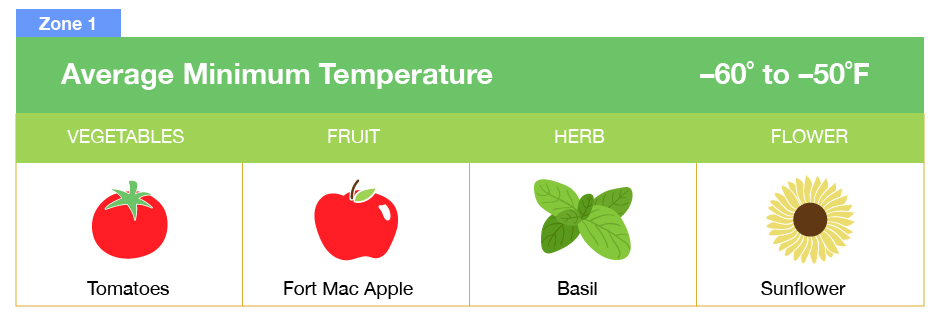
Temperature in Zone 1
Zone 1 can expect minimum average temperatures of -60 to -50 degrees F
Zone 1a has a minimum average temperature of -60 to -55 degrees F
Zone 1b has a minimum average temperature of -55 to -50 degrees F
Each of the two subzones can experience harsher temperatures depending on weather conditions.
What Plants Can I Grow in Zone 1?
Planting in Zone 1 can be quite challenging. Plants able to withstand the tundra are rare. Native plants have already adapted to the area, so it makes sense that they're a natural, excellent choice. Annuals are also a popular option, since they don't need to survive the winter. While there are relatively few non-native perennials suitable for Zone 1, some can be grown with proper planting and care.
Vegetables to Grow in Zone 1
Because most vegetables are grown as annuals, you don't have to consider the cold hardiness of the vegetables as much as the length of the growing season. Giving plants a head start indoors or in a greenhouse typically results in better success for Zone 1 vegetables.
Popular Zone 1 vegetables include:
- Beans
- Broccoli
- Cabbage
- Kale
- Lettuce
- Potatoes
- Radish
- Spinach
- Sweet Peas
- Tomatoes
Fruit Trees to Grow in Zone 1
Very few fruit trees are hardy enough to survive the extreme cold of Zone 1. Given the correct conditions, however, the following may be able to thrive:
- Chokecherry
- End apple
- Fort Mac Mac apple
- Haskap
- September Ruby apple
Herbs to Grow in Zone 1
Almost any herb can be grown as an annual in Zone 1. Consider planting these as annual herbs:
- Basil
- Chives
- Mint
- Oregano
- Rosemary
- Thyme
Flowers to Grow in Zone 1
Flowers for Zone 1 should be drought-tolerant and tremendously cold hardy. The most popular growing choices include:
- Arrowhead
- Delphinium
- Goldenrod
- Sunflower
- Lily of the Valley
- Oxeye Daisy
- Yarrow
Planting Zone 2
Located in both Alaska and the continental United States, planting Zone 2 features extremely cold average minimum temperatures of between -50 to -40 degrees F. These temperatures can present a growing challenge to many gardeners. High winds and drought conditions are found in both the tundra and plains of Zone 2. Planting native plants, growing annuals and using creative planting techniques give gardeners a growing advantage.
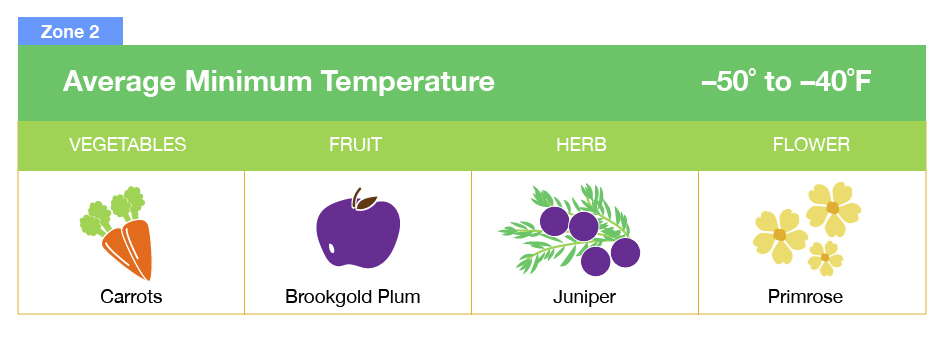
Temperature in Zone 2
Zone 2 can expect minimum average temperatures of -50 to -40 degrees F
Zone 2a has a minimum average temperature of -50 to -45 degrees F
Zone 2b has a minimum average temperature of -45 to -40 degrees F
Each of the two subzones can experience harsher temperatures depending on weather conditions.
What Plants Can I Grow in Zone 2?
Plants in Zone 2 must be able to withstand extreme cold and high levels of drought. Native plants are best adapted to the environment. Annuals are best suited for this zone, but some perennials can be grown when chosen carefully.
Vegetables to Grow in Zone 2
There are very few perennial vegetables able to withstand the extreme cold of Zone 2. Although, with added protection, it can be possible to grow asparagus as a perennial. Look for annual vegetables with a short growing season for the best results. In addition to Zone 1 vegetables, consider planting:
- Carrots
- Mustard greens
- Onions
- Parsnips
- Swiss chard
Fruit Trees to Grow in Zone 2
There are a few options for fruit trees in Zone 2. Carefully considering the planting location will help ensure success. Zone 2 hardy fruit varieties include:
- Brookgold plum
- Fall Red apple
- Fofonoff plum
- Garrington Chokecherry
- Korean pine
- Minnesota 1734 apple
- Norkent apple
- Parkland apple
- Pembina plum
Herbs to Grow in Zone 2
Zone 2 is ideal for growing annual herbs, either replanted or from self-sowing plants. The following herbs are considered cold hardy for Zone 2:
- Hyssop
- Juniper
- Turkestan Rose
Flowers to Grow in Zone 2
Native plants are your best option for tender perennials in Zone 2. However, many gardeners have success by matching plants from similar environments. Consider planting:
- Bleeding Heart
- Monkshood
- Penstemon
- Poppy
- Primrose
- Sea Holly
- Violet
Planting Zone 3
Plant hardiness Zone 3 is found throughout Alaska, the northern portions of the United States and in high altitude areas. This zone features minimum average temperatures of -40 to -30 degrees F. Depending on the geographical location of your growing space, high winds, extreme cold and low moisture may affect growing conditions.
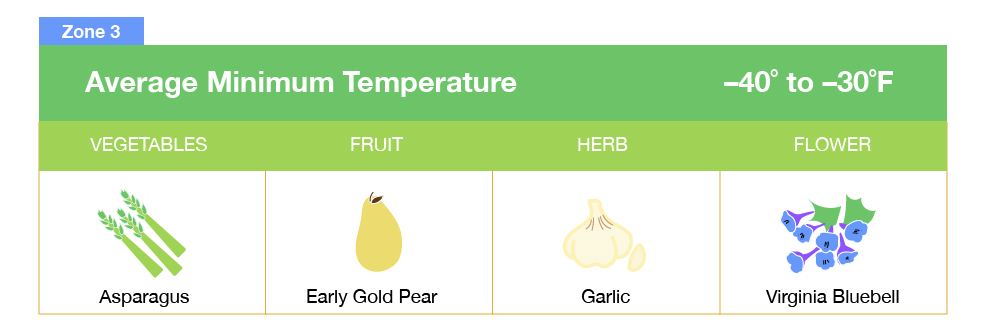
Temperature in Zone 3
Zone 3 can expect minimum average temperatures of -40 to -30 degrees F
Zone 3a has a minimum average temperature of -40 to -35 degrees F
Zone 3b has a minimum average temperature of -35 to -30 degrees F
Each of the two subzones can experience harsher temperatures depending on weather conditions.
What Plants Can I Grow in Zone 3?
The cold minimum average temperatures in Zone 3 limits plant choices to those that have adapted to low temperatures. Most native plants can be grown across the zone, regardless of altitude, as long as growing conditions are similar. The short growing season limits vegetable and flowering annuals, but you can extend the growing season by starting plants indoors or purchasing from a greenhouse.
Vegetables to Grow in Zone 3
The short growing season, combined with low soil temperatures, limits vegetable gardens in Zone 3. Adding row covers can help extend the growing season and warm the ground. Plant vegetables that quickly mature to beat early frosts. In addition to Zone 1 and 2 hardy plants, consider planting:
- Asparagus
- Celery
- Cucumbers
- Summer squash
- Winter squash
Fruit Trees to Grow in Zone 3
There are many trees well suited to Zone 3. Popular fruit tree options include:
- Cupid cherry
- Dolgo crabapple
- Early Gold pear
- Evans cherry
- Golden Spice pear
- Goodland apple
- Sweet Sixteen apple
- Toka plum
- Waneta plum
- Westcot apricot
Herbs to Grow in Zone 3
In addition to annual herbs, herbs hardy enough for Zone 3 include:
- Caraway
- Catnip
- English chamomile
- French sorrel
- Garlic
- Horseradish
- Parsley
- Peppermint
Flowers to Grow in Zone 3
There are a number of flowers hardy enough to withstand the cold temperatures of Zone 3. Popular choices include:
- Alpine Rockcress
- Aster
- Blanket Flower
- Liatris varieties
- Salvia
- Snow-in-Summer
- Spurge
- Virginia Bluebells
- Wallflower
Planting Zone 4
Planting Zone 4 covers the southern coastal areas of Alaska, northern areas of the United States and high elevations found in the western mountains. These unique climates share minimum average temperatures of between -30 to -20 degrees F. Planting in this zone is less challenging than in colder zones, but the short growing season impacts both vegetables and flower bloom times.

Temperature in Zone 4
Zone 4 can expect minimum average temperatures of -30 to -20 degrees F
Zone 4a has a minimum average temperature of -30 to -25 degrees F
Zone 4b has a minimum average temperature of -25 to -20 degrees F
Each of the two subzones can experience harsher temperatures depending on weather conditions.
What Plants Can I Grow in Zone 4?
Zone 4 is considered a cool climate suitable for growing plants hardy enough to withstand temperatures well below freezing. To combat the typically short growing season, gardeners can get a head start by starting plants indoors or purchasing starts from a greenhouse. Adding a good layer of mulch and taking preventative winter measures can help some plants survive the cold winters.
Vegetables to Grow in Zone 4
As a perennial vegetable, rhubarb is hardy to Zone 4. If started indoors, you can also add the following plants to your vegetable gardens:
- Eggplant
- Melons
- Okra
- Pumpkins
Fruit Trees to Grow in Zone 4
There are many cold hardy fruit trees appropriate for planting in Zone 4, including:
- Alderman plum
- Alexander apple
- Buartnut
- Butternut
- Ewing blue plum
- Nova pear
- Railroad apple
- Summercrisp pear
- Trent apple
Herbs to Grow in Zone 4
Many herbs become hardy to Zone 4 with nothing more than an application of mulch during the winter months, including:
- Angelica
- Bee balm
- Garden sage
- Lemon balm
- Mountain mint
- Thyme
- Winter savory
Flowers to Grow in Zone 4
There are several perennial flowers native to Zone 4 areas that are hardy even in the coldest of winters. If you're planning for Zone 4, consider these flowers:
- Coneflower
- Daylily
- Iris
- Phlox
- Plantain lily (Hostas)
Planting Zone 5
Plant hardiness Zone 5 includes the southern coastal region of Alaska, the North Central United States and portions of New England. With minimum average temperatures between -20 and -10 degrees F, this zone experiences a moderately cold winter. While the growing season is short, you can extend it by using cold frames or using started plants in your annual garden.

Temperature in Zone 5
Zone 5 can expect minimum average temperatures of -20 to -10 degrees F
Zone 5a has a minimum average temperature of -20 to -15 degrees F
Zone 5b has a minimum average temperature of -15 to -10 degrees F
Each of the two subzones can experience harsher temperatures depending on weather conditions.
What Plants Can I Grow in Zone 5?
Zone 5 gardens feature a wide range of environments. From coastal waters and woodlands to the wide plains of the Midwest, plants should not only be cold hardy, but they also need to match the growing environment. Gardens feature longer growing seasons that result in an increased vegetable harvest and extended blooms in landscaping.
Vegetables to Grow in Zone 5
Raised beds and row covers help to warm the soil in Zone 5 for a longer growing season. After spring greens are planted, fast-maturing crops are then planted. Depending on your area, some cool season vegetables may be repeated in late summer for a fall harvest, including:
- Kale
- Lettuce
- Radishes
- Spinach
- Winter greens
Fruit Trees to Grow in Zone 5
Many fruit trees are hardy to Zone 5, including:
- Harrow Delight pear
- Honeycrisp apple
- Native pawpaw trees
- Pink Lady apple
- Snow Beauty peach
- Superior plum
- Warren pear
Herbs to Grow in Zone 5
Perennial herbs hardy for Zone 5 gardens include:
- Hybrid mints
- Large-flowered calamint
- Lavender
Flowers to Grow in Zone 5
With the proper planting and care, many perennial flowers are hardy enough to survive the cold winters of Zone 5, including:
- Baptisia
- Black-eyed Susan
- Campanula
- Cinquefoil
- Russian Sage
Planting Zone 6
USDA Hardiness Zone 6 covers a large portion of the United States. Known as a generally mild climate, the average minimum winter temperature is between -10 to 0 degrees F. With cold winter and mild-to-hot summers, you have many growing options in Zone 6.

Temperature in Zone 6
Zone 6 can expect minimum average temperatures of -10 to -0 degrees F
Zone 6a has a minimum average temperature of -10 to -5 degrees F
Zone 6b has a minimum average temperature of -5 to -0 degrees F
Each of the two subzones can experience harsher temperatures depending on weather conditions.
What Plants Can I Grow in Zone 6?
Zone 6 features many plants ideal for gardening and landscaping. Seed companies, nurseries and garden centers offer Zone 6 gardeners countless options. In many areas, spring, summer and fall blooms and vegetables are all possible.
Vegetables to Grow in Zone 6
In Zone 6, the extended garden season and hotter summer temperatures make growing a wide variety of vegetables popular. Temperatures remain cool enough for rhubarb and asparagus, but get warm enough for melons and watermelon. Look to plant vegetables according to the length of the growing season. Vegetables that tend to do well are:
- Bush beans
- Butter lettuce
- Indeterminate tomatoes
- Longer season melons
- Winter squash
Fruit Trees to Grow in Zone 6
Peaches perform especially well in Zone 6. Some varieties to try are:
- Jefferson
- Late Crawford
- Loring
- Madison
- Nectar
- Red Globe
Herbs to Grow in Zone 6
Due to warm springs, herbs that reseed themselves are often popular Zone 6 choices. These include:
- Borage
- Coriander
- Dill
- False chamomile
- Oregano
Flowers to Grow in Zone 6
Because Zone 6 features distinct seasons of spring, summer and fall, flowers are available and will bloom for several months. In addition to cold hardy flowers such as pansies and snapdragons, extend your growing season by planting:
- False sunflower
- Floribunda rose
- Flowering fern
- Japanese Bottlebrush
- Lady's Mantle
- Sedum
Planting Zone 7
Planting Zone 7 reaches across approximately 15 U.S. states. This zone features cool winters with average minimum temperatures falling between 0 to 10 degrees F. Gardens in this zone have multiple plant options from seed catalogues, local home stores, nurseries and greenhouses.
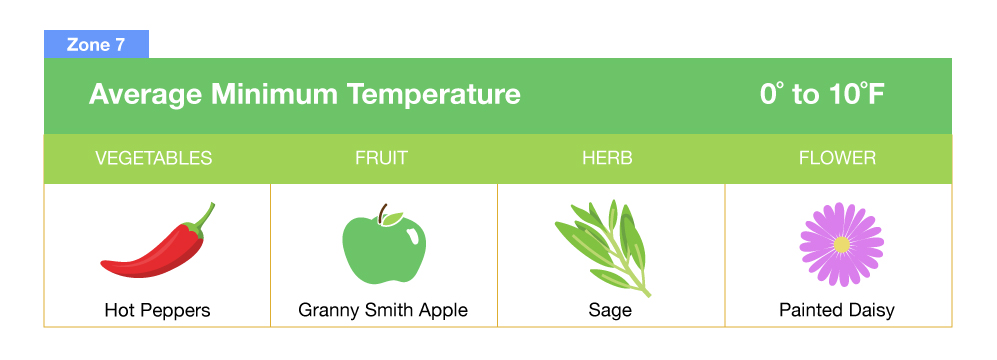
Temperature in Zone 7
Zone 7 can expect minimum average temperatures of 0 to 10 degrees F
Zone 7a has a minimum average temperature of 0 to 5 degrees F
Zone 7b has a minimum average temperature of 5 to 10 degrees F
Each of the two subzones can experience harsher temperatures depending on weather conditions.
What Plants Can I Grow in Zone 7?
Zone 7 contains many different growing climates, from the Eastern coastal areas through the Oklahoma prairies to the arid regions of the southwest and up into the forests of Oregon and Washington. The region's wide variety in climates means that other considerations often need to be made to accommodate for drought tolerance and to adequately adjust soil conditions. Many Zone 7 hardy plants can be grown successfully in multiple locations with adjustments made to address their specific needs.
Vegetables to Grow in Zone 7
Frost and early spring cold snaps can damage young vegetables. Providing row covers or cold frames can help protect against early spring or late fall damage. The long, hot summers, combined with the milder winters provide ideal growing temperatures for almost all vegetables. Although artichoke can be grown as an annual starting in Zone 4, in Zone 7 this decorative and edible plant becomes a perennial favorite. Add to your planting list:
- Arugula
- Hot peppers
- Long growing season vegetables
- Sweet peppers
- Turnips
Fruit Trees to Grow in Zone 7
A wide variety of fruit trees produce well in Zone 7, including:
- Bing cherry
- Blue Java banana
- Contender peach
- Cortland apple
- Fuji apple
- Fuyu persimmon
- Granny Smith apple
- Moorpark apricot
- Ozark plum
- Parker pear
- Rainier Sweet cherry
- Red Gold nectarine
- Scout apricot
- Stella cherry
- Turkey fig
- Wide variety of mulberries, elderberries and pawpaw trees
Herbs to Grow in Zone 7
In addition to most annual herbs, a wide variety of perennial herbs survive well in Zone 7. Although some varieties of rosemary are Zone 7 hardy, they don't perform as well as in warmer climates. Herbs to consider adding to your Zone 7 garden include:
- Feverfew
- Marjoram
- Rue
- Sage
- Tarragon
Flowers to Grow in Zone 7
The hot summers in Zone 7 allow for the bloom of most flowering annuals. In addition, many perennials are considered hardy to Zone 7, including:
- Butterfly weed
- Candytuft
- Chrysanthemum
- Clematis
- Forget-me-not
- Four O'clock
- Painted daisy
- Peony
Planting Zone 8
Zone 8 is considered one of the warmest plant hardiness zones for a large portion of the southern United States. Extending up the western coast, Zone 8 features average minimum winter temperatures of 10 to 20 degrees F. With hot summers and mild winters, growers typically enjoy a long planting season.
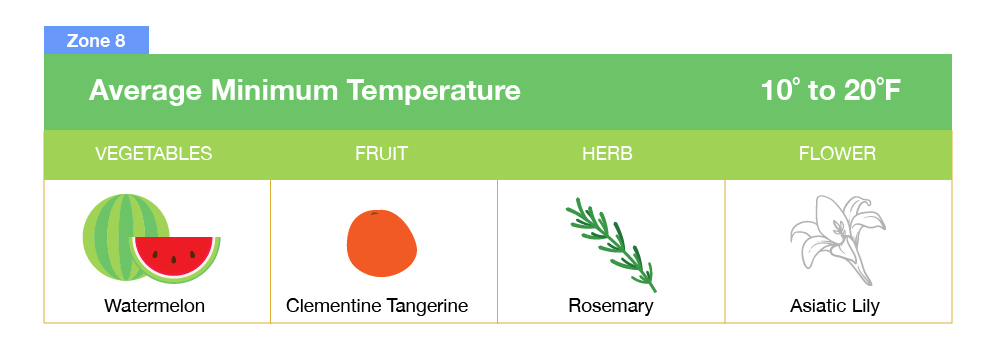
Temperature in Zone 8
Zone 8 can expect minimum average temperatures of 10 to 20 degrees
Zone 8a has a minimum average temperature of 10 to 15 degrees F
Zone 8b has a minimum average temperature of 15 to 20 degrees F
Each of the two subzones can experience harsher temperatures depending on weather conditions.
What Plants Can I Grow in Zone 8?
Plants hardy for Zone 8 love mild winters and long, hot summers. With a wide range of moisture and sunlight requirements, growers should narrow down a potential plant list first by zone, and then by specific growing climates.
Vegetables to Grow in Zone 8
Many gardeners in Zone 8 grow vegetables three times a year, especially with the aid of cold frames and row covers. Cool weather plants like spinach, lettuce and peas can be grown in both the spring and the fall. Even your summer vegetable harvest can be extended by planting every two weeks. Vegetables that thrive in the summer heat of Zone 8 include:
- Bolt resistant lettuce varieties
- Cantaloupe
- Field peas
- Hot peppers
- Okra
- Tomatoes
- Watermelon
Fruit Trees to Grow in Zone 8
Many fruit trees are hardy to both the mild winters and hot summers of Zone 8, including:
- Abacá banana
- Alma fig
- Anna apple
- Bronze banana
- Bryan apricot
- Clementine tangerine
- Darjeeling banana
- Gala apple
- Jujube varieties
- Kumquat and Limequat varieties
- Marsh grapefruit
- Meyer lemon
- Montmorency cherry
- Multiple varieties of peaches and plums
- Ruby grapefruit
- Washington orange
Herbs to Grow in Zone 8
Many of the herbs hardy to Zone 8 are native to Mediterranean areas. They thrive in long, hot summers and are often drought resistant. Consider adding these herbs to your Zone 8 herb garden:
- Bay laurel
- Marjoram
- Mexican oregano
- Rosemary
- Sage
Flowers to Grow in Zone 8
Zone 8 flowers should be able to stand up to the heat of the hot summers. Providing shade and plenty of moisture can help push your flowers through the hottest of days. Flowers well suited for Zone 8 gardens include:
- Asiatic lily
- Hardy geranium
- Lantana
- Mexican petunia
- Phlox
Planting Zone 9
Planting Zone 9 is considered a year-round planting zone. Located in California, Arizona, Texas, Florida and along the Gulf of Mexico coast, this zone features warm winters and hot summers. With an average minimum winter temperature of 20 to 30 degrees F, Zone 9 features active gardens throughout the entire year.

Temperature in Zone 9
Zone 9 can expect minimum average temperatures of 20 to 30 degrees F
Zone 9a has a minimum average temperature of 20 to 25 degrees F
Zone 9b has a minimum average temperature of 25 to 30 degrees F
Each of the two subzones can experience harsher temperatures depending on weather conditions.
What Plants Can I Grow in Zone 9?
Long, hot summers and mild winter conditions make the heat more of an issue than the cold in this zone. Tropical plants with low water requirements thrive in Zone 9. Because of the extreme heat, spring gardening begins much earlier and fall gardens produce much longer than in other zones.
Vegetables to Grow in Zone 9
Although the growing season in Zone 9 extends over 9 months, you shouldn't expect a continuous supply of summer veggies. The extreme heat of the summer breaks the vegetable garden season into winter, spring and fall gardening, versus the stereotypical summer gardening. Most areas will only produce peppers, okra and extremely heat-tolerant vegetables during August. However, you'll likely be able to grow the following vegetables throughout the winter:
- Broccoli
- Brussel sprouts
- Cabbage
- Cauliflower
- Greens
- Spinach
Fruit Trees to Grow in Zone 9
Instead of considering the cold hardiness, growers in Zone 9 actually need to consider the heat tolerance of certain plants. Apples, pears, peaches and cherries require colder weather than Zone 9 provides. Instead of these popular fruit options, consider planting the following citrus and tropical fruit trees:
- Avocado
- Calamondin
- Giant pumelo
- Hardy kiwi
- Mandarin orange
- Olives
- Passionfruit
- Starfruit
- Trifoliate orange
Herbs to Grow in Zone 9
Certain cool season herbs, such as cilantro and parsley, may be grown throughout the winter in Zone 9. Other herbs that tolerate the heat well include:
- Basil
- Bay laurel
- Chives
- Coriander
- Lemon thyme
- Marjoram
- Mint
Flowers to Grow in Zone 9
Zone 9 flower gardens will showcase blooms year-round. Cold-hardy plants perform well during the mild winters, while tropical perennials are the centerpieces of long, hot summers. Zone 9 flowering plants include:
- Black-eyed Susan
- Canna
- Dahlia
- Hydrangea
- Rhododendrons
- Wisteria
- Zinnia
Planting Zone 10
Southern inland California, southern Florida and Hawaii are the three small areas where the average minimum winter temperature only falls between 30 to 40 degrees F. The ability of Zone 10 gardeners to avoid freezing temperatures is a huge bonus for winter gardening, but the extreme heat of the summer months limits planting possibilities.

Temperature in Zone 10
Zone 10 can expect minimum average temperatures of 30 to 40 degrees F
Zone 10a has a minimum average temperature of 30 to 35 degrees F
Zone 10b has a minimum average temperature of 35 to 40 degrees F
Each of the two subzones can experience harsher temperatures depending on weather conditions.
What Plants Can I Grow in Zone 10?
Tropical plants top the list for what grows well in Zone 10. With few frosts, the high heat and humidity of summer can become a major concern for growers.
Vegetables to Grow in Zone 10
Cool season crops, including lettuces, radishes and peas, can be grown in Zone 10 during the winter with little fear of cold damage. Summer vegetables must be able to handle the long, hot days of summer. Consider including these vegetables in your Zone 10 garden:
- Bitter melon
- Jicama
- Peanuts
- Malabar spinach
- Tomatillos
Fruit Trees to Grow in Zone 10
Zone 10 is an ideal growing zone for many exotic fruit trees, including:
- Allspice tree
- Apple guava
- Carica papaya
- Dwarf Cavendish banana
- Jackfruit tree
- June plum
- Soursop tree
Herbs to Grow in Zone 10
The heat of summer in Zone 10 is ideal for growing a few unique herbs, such as:
- Curry leaf
- Galangal
- Ginger
- Mexican tarragon
- Miracle fruit
Flowers to Grow in Zone 10
Tropical plants survive the mild winters and hot summers of Zone 10 with ease. Some beautiful additions to your flower garden may include:
- Aeoniums
- Agave
- African lily
- Delta maidenhair fern
- Floss flower
- Geraniums
- Hummingbird mint
- Ornamental onion
- Peruvian lily
- Various aloes
Planting Zone 11
Planting Zone 11 is found in Hawaii, the Florida Keys, Puerto Rico and a few small areas of the Continental United States. This extremely warm zone features mellow winters with an average minimum winter temperature of between 40 to 50 degrees F. Cold hardiness is not a factor in this zone, since it has zero frost days. Instead, growers here must consider the impact heat has on their planting choices.
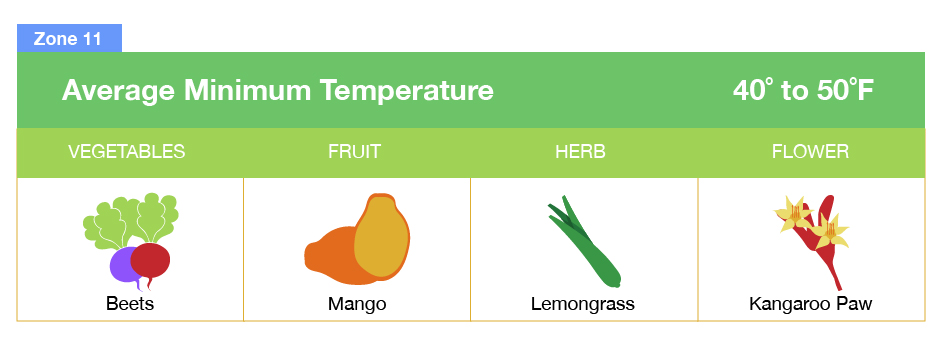
Temperature in Zone 11
Zone 11 can expect minimum average temperatures of 40 to 50 degrees F
Zone 11a has a minimum average temperature of 40 to 45 degrees F
Zone 11b has a minimum average temperature of 45 to 50 degrees F
Each of the two subzones can experience harsher temperatures depending on weather conditions.
What Plants Can I Grow in Zone 11?
Tropical plants are the highlight of Zone 11. With long, hot summers and warm winters, Zone 11 growers need to look for plants that are heat tolerant. Traditionally cold season plants, such as pansies and spinach, will have a limited growing season in the even the coolest part of winter here (which is rarely cold at all). Plants native to the area have the best chance of surviving the heat of summer.
Vegetables to Grow in Zone 11
Vegetables often started in late spring or early summer can be planted in late winter in Zone 11. Gardening happens year-round with the rotation of plants according to the temperature. A few cool season vegetables appropriate for winter gardening in Zone 11 include:
- Beets
- Cabbage
- Carrots
- Kale
- Radishes
- Sweet Peas
- Swiss chard
Fruit Trees to Grow in Zone 11
Most citrus and tropical fruits thrive in Zone 11. Some exotic choices include:
- Jaboticaba
- Macadamia
- Mango
- Moringa tree
- Natal plum
- Sea grape
Herbs to Grow in Zone 11
Growing herbs in Zone 11 can be difficult because of the extreme heat of summer. Many will not produce seeds due to the heat, so they must be planted as annuals during the cooler months. Some herbs you can begin planting in early spring include:
- Basil
- Chives
- Lemongrass
- Mexican oregano
- Mint
- Thyme
Flowers to Grow in Zone 11
The mild winters of Zone 11 allow for the growth of many cool season flowers without any worry of frost. However, these flowers usually wither away under the extreme summer temperatures. Flowers able to withstand the long, hot summers of Zone 11 include:
- Anemone coronaria
- Begonias
- Bougainvillea
- Drumstick allium
- Kangaroo paw
- Ponytail palm
Planting Zones 12 and 13
Planting Zones 12 and 13 are not found in the continental United States, but are located in both Hawaii and Puerto Rico. These two plant hardiness zones are extremely warm, tropical environments that are best suited for plants tolerant of intense heat. With the average minimum winter temperature between 50 and 70 degrees F, Zones 12 and 13, the warmest of all the USDA hardiness zones, feature tropical plants and exotic fruits.
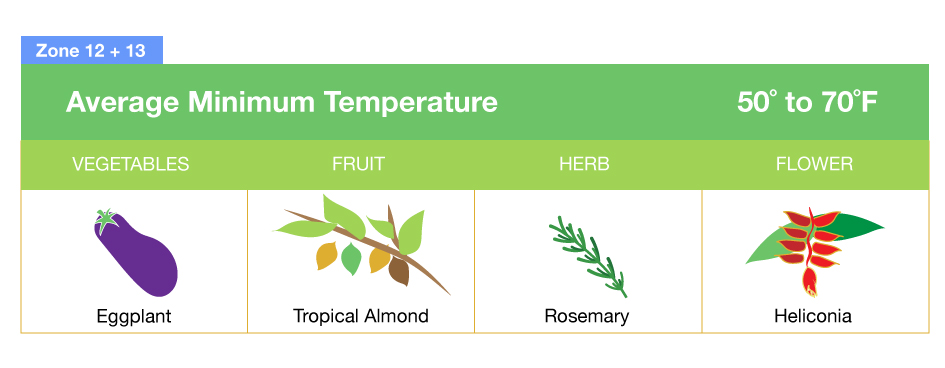
Temperatures in Zone 12 and 13
Zone 12 can expect minimum average temperatures of 50 to 60 degrees F
Zone 12a has a minimum average temperature of 50 to 55 degrees F
Zone 12b has a minimum average temperature of 55 to 60 degrees F
Zone 13 can expect minimum average temperatures of 60 to 70 degrees F
Zone 13a has a minimum average temperature of 60 to 65 degrees F
Zone 13b has a minimum average temperature of 65 to 70 degrees F
The subzones in both Zones 12 and 13 can experience harsher temperatures depending on weather conditions.
What Plants Can I Grow in Zone 12 and 13?
Heat tolerance and maximum germination temperatures become an issue in Zones 12 and 13. Tropical plants are the key to gardening and landscaping in the extreme heat of both these zones. Growers germinate indoors, purchase plants from nurseries and grow many vegetables during the cooler winter months.
Vegetables to Grow in Zones 12 and 13
Almost all vegetables can be grown in Zones 12 and 13 by simply planting during cooler months and by using shade and irrigation to reduce heat. Planting summer vegetables early will bring a harvest in late June or early July. The late summer monsoon season often brings relief from the heat and generally provides another chance for planting. Look for plants that are heat and drought tolerant and have a short growing season, such as:
- Bush beans
- Eggplant
- Hot peppers
- Summer squashes
- Tomatoes
Fruit Trees to Grow in Zones 12 and 13
Exotic fruits native to extremely hot climates are ideal for growing in Zones 12 and 13. Consider planting these unique fruit trees:
- African apricot
- African breadfruit
- Ackee
- Alupag
- Amazon tree-grape
- Bacuri cascudo
- Bignay
- Black pepper
- Imbe
- Java Olive
- Tropical almond
Herbs to Grow in Zones 12 and 13
Just like vegetables, growing herbs in Zones 12 and 13 requires planning and plenty of moisture. Look for heat-tolerant options, such as:
- Borage
- Cilantro
- Culantro
- Rosemary
- Sage
- Savory
Flowers to Grow in Zones 12 and 13
With the proper care, many tropical plants will bloom beautifully in this hot climate. Consider planting flowers from the following tropical families:
- Musaceae
- Strelitziaceae
- Heliconia
- Zingiberaceae
- Costaceae
- Cannaceae
- Marantaceae
- Lowiaceae
No matter what zone you live in one thing is certain, you'll need watering equipment. Gilmour offers the best quality in lawn and garden watering equipment you can find.
Hoses | Nozzles | Sprinklers | Watering Timers | Connectors
Where Is Zone 9 For Gardening
Source: https://gilmour.com/planting-zones-hardiness-map
Posted by: sansomcombehe.blogspot.com

0 Response to "Where Is Zone 9 For Gardening"
Post a Comment